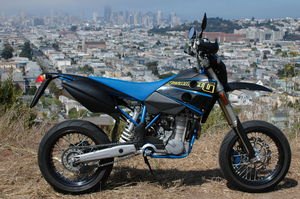New commitment to service / warranty...
Perhaps the most important step in the right direction has come with an increase of the normal 3 month warranty out to 12 months. Husaberg now offers a better warranty than bikes like its KTM brethren (3 months) and Yamaha's WR models.
Husaberg management claim that they are now totally committed to after sales service and support, an area where the brand has been lacking in previous years.
 Perhaps even more important for customer satisfaction is that all 2003 Husaberg machines are put through an extensive pre-delivery regimen at the WA based national distribution centre, before being sent on to dealers.
Perhaps even more important for customer satisfaction is that all 2003 Husaberg machines are put through an extensive pre-delivery regimen at the WA based national distribution centre, before being sent on to dealers.
Nothing like your new bike leaking oil the first week you get it, this new system of doing things hopes to prevent such happenings.
Husaberg also claim to be working hard to ensure a large stock of components and service items are always available and warehoused at their Australian distribution centre. I was impressed with my walk around their facility, the manager I spoke to impressed with his common sense approach to how he aims to improve the name of the brand.
Husaberg - History
The Husaberg brand came about from a group of Husqvarna engineers breaking away from Husky to produce their own machines.



They had immediate success in European racing circles and started producing machines for sale. They were then brought in to the KTM fold to help them develop Husaberg further.
In recent years KTM has learnt many lessons in areas of quality control and parts distribution, and this is where the benefits for Husaberg will show through. But each company’s products will remain totally separate.


 By the time I parked the van and made my way over for a handshake, the man was gone. Surveying the area from behind the dark anonymity of my sunglasses, I noted with a sense of worry that Beckman's trailer was devoid of the Husaberg I was slated to ride. Scanning the track revealed a few KTMs, a Yamaha and the man in black, but no yellow-and-blue Husaberg. A
By the time I parked the van and made my way over for a handshake, the man was gone. Surveying the area from behind the dark anonymity of my sunglasses, I noted with a sense of worry that Beckman's trailer was devoid of the Husaberg I was slated to ride. Scanning the track revealed a few KTMs, a Yamaha and the man in black, but no yellow-and-blue Husaberg. A
 Super Motard. It means "Super Biker" in French, and has roots in the ABC Wide World of Sports TV program's Superbikers race series from the late 70's and early 80'. In these races, sticky roadracing slicks were mounted on big-bore dirtbikes and raced on eclectic half pavement/half dirt tracks by some of the fastest road and motocross racers in the business, to see who would become the "Super Biker" of the world.
Super Motard. It means "Super Biker" in French, and has roots in the ABC Wide World of Sports TV program's Superbikers race series from the late 70's and early 80'. In these races, sticky roadracing slicks were mounted on big-bore dirtbikes and raced on eclectic half pavement/half dirt tracks by some of the fastest road and motocross racers in the business, to see who would become the "Super Biker" of the world. Like all things odd, the French adopted Motard racing as their own after it was abandoned by our throw-away culture. It caught on throughout Europe,

